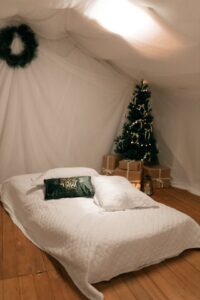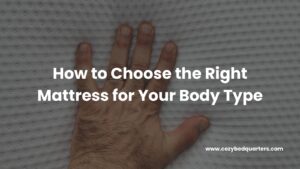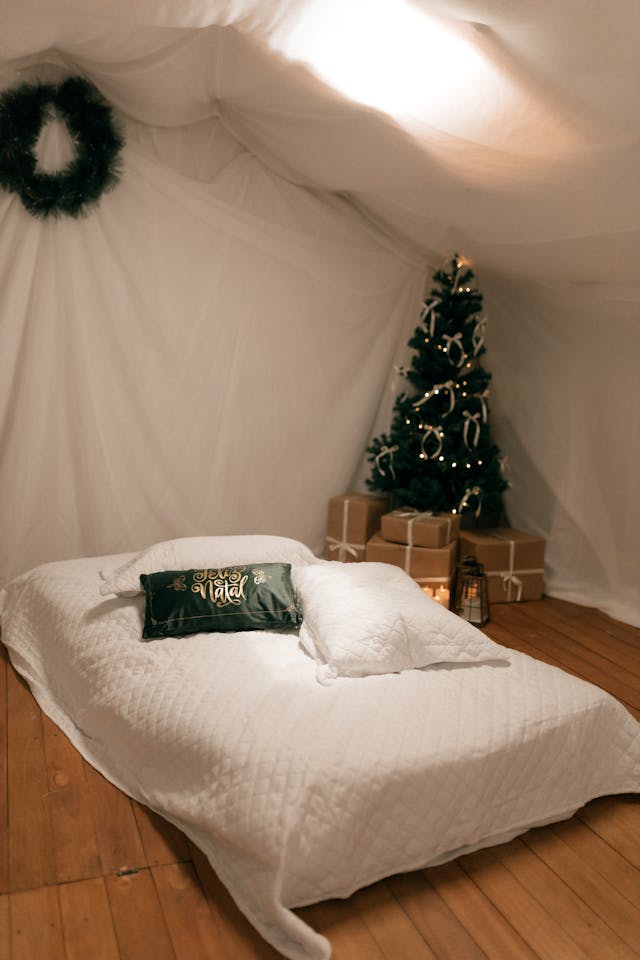Duvet vs Comforter: 7 Key Differences for Cozy Sleep
Updated 2025
Duvet vs Comforter comes down to parts and care — a duvet is an insert plus a removable cover for easy washing and quick style swaps; a comforter is a single quilted piece you use as-is for grab-and-go simplicity.
Ever stood in a store aisle or scrolled online feeling torn? Maybe you remember a chilly night when your bed didn’t feel right, or a move when swapping covers felt like a small fresh start. This guide gives you the clear, friendly difference so you can pick bedding that fits your sleep habits without extra fuss. For layering basics, see our Cozy Bed Quarters bedding guide.
Key Takeaways
- Duvet vs comforter: two-piece (insert + cover) vs one-piece quilted blanket.
- Duvet covers wash easily and let you change style fast; inserts are cleaned less often.
- Comforters are ready-made and simple to use but bulkier to launder.
- Construction (baffles, quilting) keeps fill even and affects warmth and loft.
- Size, drape, and materials change how your bed looks and feels across seasons.
Duvet vs Comforter: Quick Overview
In one line: duvet = insert + cover; comforter = single piece you use as-is. Pick versatility and easier laundry with a duvet, or choose instant simplicity with a comforter.
- Duvets tend to sit closer to the mattress footprint for a tidy look; comforters often drape for a layered vibe.
- Many comforters arrive as matching sets; duvet covers let you restyle with a quick swap.
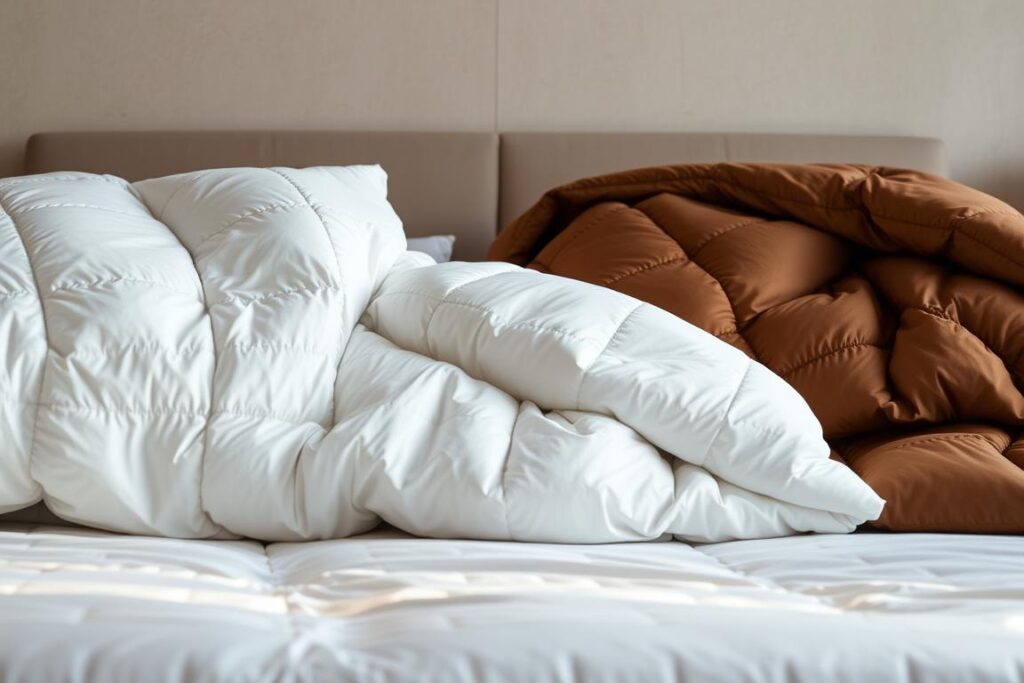
Caption: Side-by-side look — duvet (insert + cover) on the left, comforter on the right.
Definitions You Can Shop By
Here’s exactly what you’re buying. Clear definitions remove guesswork so your choice matches how you sleep and care for laundry.
What is a duvet?
A duvet is a two-piece system: an insert (filled with down, feathers, wool, cotton, or synthetic) that slips inside a removable duvet cover. Ties, loops, buttons, or zippers help keep the insert aligned so it doesn’t bunch up. You wash the cover often and the insert occasionally.
What is a comforter?
A comforter is a single quilted blanket with built-in outer fabric and fill. Quilted channels or box stitches keep the fill evenly spread. It’s ready to use out of the bag, but being one bulky piece makes washing trickier.
Where do quilts fit?
Quilts are thinner, layered blankets with batting stitched between two fabrics. They’re usually flatter and often reversible — great as a light top layer or for seasonal texture.
- Insert and cover can be bought separately, so you can refresh style without replacing the insert.
- Attachment points (ties, loops, buttons) matter for keeping a duvet insert in place.
- Top sheets are optional; daily bed-making is faster with one piece, while two-piece systems make laundry simpler long-term.
Materials & Construction (Why It Feels the Way It Feels)
Fills and fabrics drive warmth, breathability, and durability. Your comfort across seasons starts here.
Natural fills
Down/feather offers plush loft with low weight. Wool insulates yet wicks moisture, great for cool or damp climates. Breathable cotton shells (often higher thread count) help contain fill and improve durability.
Synthetic fills
Polyester/down-alternative mimics down’s loft at a friendlier price and dries faster — common in comforters for easy care.
Stitching & baffles
Box stitching, sewn baffles, and quilted channels keep fill from clumping so warmth stays even, whether you choose a duvet insert or a comforter.
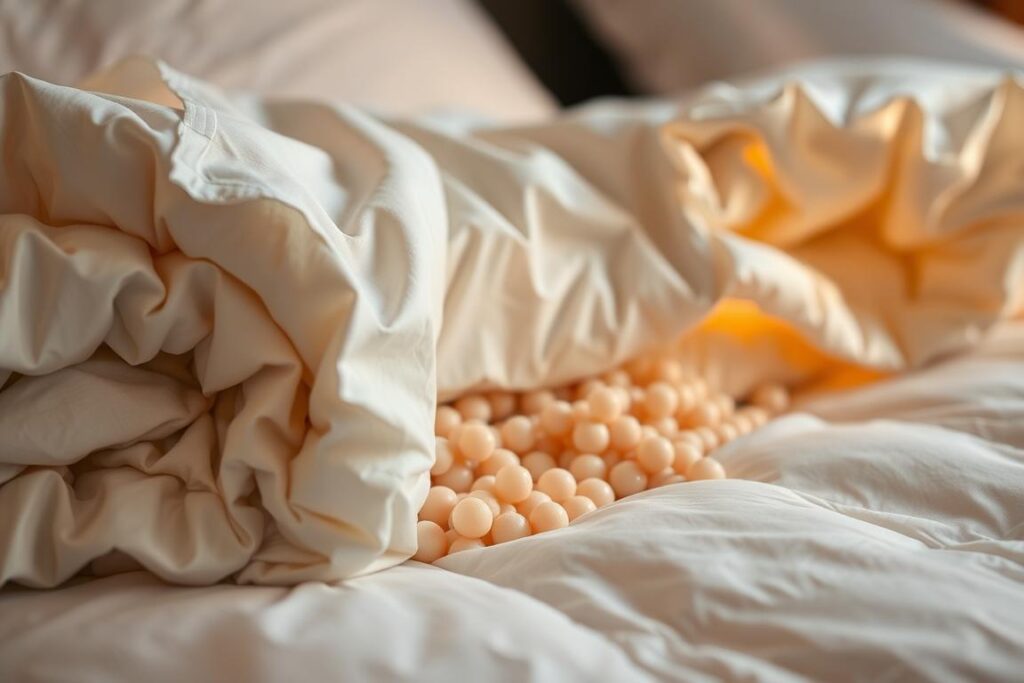
Caption: Fill types and shell fabrics shape loft, breathability, and lifespan.
For a healthier sleep setup and smart shopping, skim the Sleep Foundation’s hygiene tips and compare trusted eco-labels in this Eachnight guide to bedding certifications.
- Hot sleeper? Pair a low-loft insert with a breathable cotton or linen cover. See Percale vs sateen sheets for cooler-feeling weaves.
- Cold sleeper? Medium to high loft down or wool traps warmth without heavy weight.
Warmth & Seasonality
Set your bed for the weather. Swap loft and cover fabric to move from winter-cozy to summer-cool without rebuying everything.
- Warm months: light synthetic or thin wool with lightweight cotton or linen cover.
- Shoulder seasons: medium-loft insert; layer a quilt only when needed.
- Cold months: high-loft down or wool with tighter-weave cotton or flannel cover.
Guide to bedding has layering ideas if you like to fine-tune warmth by month.
Size, Fit & Style on Your Mattress
Right dimensions = intentional drape. Comforters often offer generous overhang for a layered look; duvets typically track closer to mattress edges for a neater silhouette.
Typical ranges (queen example)
- Duvets: ~88–94″ × 90″ (closer fit to mattress footprint).
- Comforters: ~86–100″ × 96″ (more side drop for visual fullness).
Have a thick mattress or topper? Size up to cover the sides. Add-ons like Euro shams can boost the polished look without extra warmth. For more styling contrasts, see this friendly breakdown from Apartment Therapy.
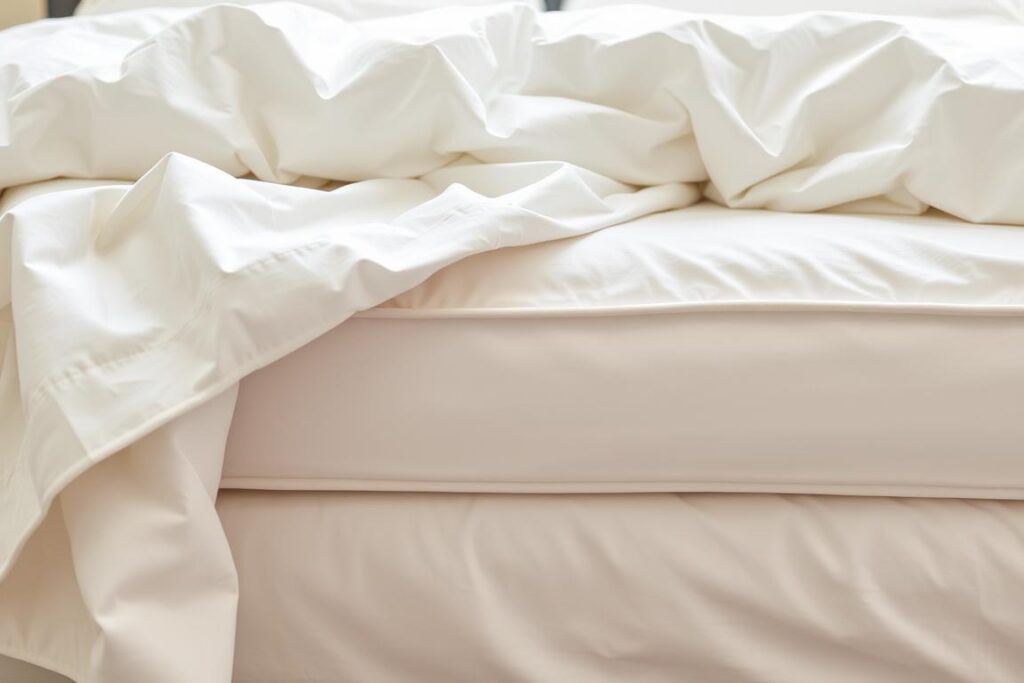
Caption: Comforters usually drape lower; duvets sit neater within the mattress footprint.
Care, Cleaning & Everyday Maintenance
Keep it fresh with a quick rhythm. Wash duvet covers every 2–4 weeks; wash inserts 1–2× per year or after spills. Comforters may need a laundromat or professional cleaning.
- Use gentle cycles and low heat; air-dry inserts or tumble low with dryer balls to protect loft.
- Attach corner ties/loops and fluff after washing to prevent clumps.
- Top sheet users can stretch time between cover washes.
Need a crash course on assembly? Watch: how to put on a duvet cover.
Price & Value (Total Cost of Ownership)
Look past the sticker price. Comforter sets can be budget-friendly and instantly coordinated. Duvets often cost more up front (insert + cover) but become cheaper to restyle because you replace only the cover.
- Typical queen prices (snapshots): comforter sets ~$30–$300; covers ~$25–$350; natural-fill inserts ~$80–$300.
- Prioritize shell durability and fill retention — that’s what you’ll feel after year two.
- Setting up a guest space? See Best bedding for guest room for value combos.
Which Should You Choose?
Match the choice to your habits. Pick what fits your laundry routine, style preferences, and how warm you sleep.
Choose a comforter if…
Pros: ready to use, coordinated sets, easy daily bed-making.
Cons: bulkier to launder; seasonal changes may mean replacing the whole piece.
Choose a duvet if…
Pros: wash the cover often, swap inserts by season, change looks fast with new covers.
Cons: two pieces to manage; you may fiddle with ties or closures.
Edge cases
Hot climate? Use lighter fills or a thin quilt layer. Love layered looks? Add a reversible quilt for texture without extra heat. Prefer a one-piece but want protection? You can put a removable cover over a comforter for easier washing.
FAQ
What’s the main difference between a duvet and a comforter?
A duvet is an insert inside a removable cover; a comforter is a single quilted blanket. That difference changes laundry, styling, and how the top layer drapes on the bed.
Do I need a top sheet with a duvet?
Not necessarily. Many follow a European style (no top sheet) because the duvet cover is washable. If you like extra crispness or less frequent cover washing, add a top sheet.
How often should I wash a duvet insert?
About once or twice a year, or after spills. Wash the duvet cover every 2–4 weeks; it takes the brunt of daily use.
Can I use a duvet cover on a comforter?
Yes. It protects the comforter and lets you change style quickly. Make sure the cover and comforter sizes match and secure with internal ties if available.
What size duvet fits a queen mattress?
Many queen duvets run ~88–94″ × 90″. Size up if you have a thick mattress or topper and want more side coverage.
Conclusion
Bottom line: in the duvet vs comforter choice, pick the two-piece duvet for easier cleaning and fast style changes, or go comforter for set-and-forget simplicity. Match fill and fabric to season and sleep style, and size to your mattress for the drape you want. For more layering and fabric tips, explore our Cozy Bed Quarters guide to bedding.



